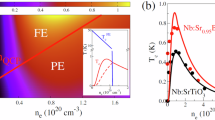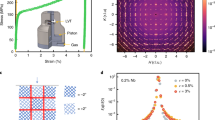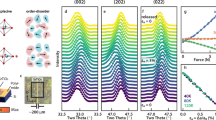Abstract
SrTiO3, a quantum paraelectric1, becomes a metal with a superconducting instability after removal of an extremely small number of oxygen atoms2. It turns into a ferroelectric upon substitution of a tiny fraction of strontium atoms with calcium3. The two orders may be accidental neighbours or intimately connected, as in the picture of quantum critical ferroelectricity4. Here, we show that in Sr1−xCaxTiO3−δ (0.002 < x < 0.009, δ < 0.001) the ferroelectric order coexists with dilute metallicity and its superconducting instability in a finite window of doping. At a critical carrier density, which scales with the Ca content, a quantum phase transition destroys the ferroelectric order. We detect an upturn in the normal-state scattering and a significant modification of the superconducting dome in the vicinity of this quantum phase transition. The enhancement of the superconducting transition temperature with calcium substitution documents the role played by ferroelectric vicinity in the precocious emergence of superconductivity in this system, restricting possible theoretical scenarios for pairing.
This is a preview of subscription content, access via your institution
Access options
Access Nature and 54 other Nature Portfolio journals
Get Nature+, our best-value online-access subscription
$32.99 / 30 days
cancel any time
Subscribe to this journal
Receive 12 print issues and online access
$259.00 per year
only $21.58 per issue
Buy this article
- Purchase on SpringerLink
- Instant access to full article PDF
Prices may be subject to local taxes which are calculated during checkout




Similar content being viewed by others

References
Müller, K. A. & Burkhard, H. SrTiO3: an intrinsic quantum paraelectric below 4 K. Phys. Rev. B 19, 3593–3602 (1979).
Schooley, J. F., Hosler, W. R. & Cohen, M. L. Superconductivity in semiconducting SrTiO3 . Phys. Rev. Lett. 12, 474–477 (1964).
Bednorz, J. G. & Müller, K. A. Sr1−xCaxTiO3: an XY quantum ferroelectric with transition to randomness. Phys. Rev. Lett. 52, 2289–2292 (1984).
Rowley, S. E. et al. Ferroelectric quantum criticality. Nat. Phys. 10, 367–372 (2014).
Lin, X., Zhu, Z., Fauqué, B. & Behnia, K. Fermi surface of the most dilute superconductor. Phys. Rev. X 3, 021002 (2013).
Lin, X. et al. Critical doping for the onset of a two-band superconducting ground state in SrTiO3−δ . Phys. Rev. Lett. 112, 207002 (2014).
Takada, Y. Theory of superconductivity in polar semiconductors and its application to n-type semiconducting SrTiO3 . J. Phys. Soc. Jpn 45, 786–794 (1978).
Ruhman, J. & Lee, P. A. Superconductivity at very low density: the case of strontium titanate. Phys. Rev. B 94, 224515 (2016).
Edge, J. M., Kedem, Y., Aschauer, U., Spaldin, N. A. & Balatsky, A. V. Quantum critical origin of the superconducting dome in SrTiO3 . Phys. Rev. Lett. 115, 247002 (2015).
Gorkov, L. P. Phonon mechanism in the most dilute superconductor: n-type SrTiO3 . Proc. Natl Acad. Sci. USA 113, 4646–4651 (2016).
Itoh, M. et al. Ferroelectricity induced by oxygen isotope exchange in strontium titanate perovskite. Phys. Rev. Lett. 82, 3540–3543 (1999).
Uwe, H. & Sakudo, T. Stress-induced ferroelectricity and soft phonon modes in SrTiO3 . Phys. Rev. B 13, 271–286 (1976).
Kleemann, W., Schäfer, F. J., Müller, K. A. & Bednorz, J. G. Domain state properties of the random-field xy-model system Sr1−xCaxTiO3 . Ferroelectrics 80, 297–300 (1988).
Kleemann, W., Albertini, A., Kuss, M. & Lindner, R. Optical detection of symmetry breaking on a nanoscale in SrTiO3:Ca. Ferroelectrics 203, 57–74 (1997).
Hemberger, J. et al. Quantum paraelectric and induced ferroelectric states in SrTiO3 . J. Phys. Condens. Matter 8, 4673–4690 (1996).
Carpenter, M. A., Howard, C. J., Knight, K. S. & Zhang, Z. Structural relationships and a phase diagram for (Ca, Sr)TiO3 perovskites. J. Phys. Condens. Matter 18, 10725–10749 (2006).
Wang, Y. G., Kleemann, W., Zhong, W. L. & Zhang, L. Impurity-induced phase transition in quantum paraelectrics. Phys. Rev. B 57, 13343–13346 (1998).
Spinelli, A., Torija, M. A., Liu, C., Jan, C. & Leighton, C. Electronic transport in doped SrTiO3: conduction mechanisms and potential applications. Phys. Rev. B 81, 155110 (2010).
Edwards, P. P. & Sienko, M. J. Universality aspects of the metal–nonmetal transition in condensed media. Phys. Rev. B 17, 2575–2581 (1978).
Behnia, K. On mobility of electrons in a shallow Fermi sea over a rough seafloor. J. Phys. Condens. Matter 27, 375501 (2015).
Allen, S. J. et al. Conduction-band edge and Shubnikov–de Haas effect in low-electron-density SrTiO3 . Phys. Rev. B 88, 045114 (2013).
Shi, Y. et al. A ferroelectric-like structural transition in a metal. Nat. Mater. 12, 1024–1027 (2013).
Kolodiazhnyi, T., Tachibana, M., Kawaji, H., Hwang, J. & Takayama-Muromachi, E. Persistence of Ferroelectricity in BaTiO3 through the insulator–metal transition. Phys. Rev. Lett. 104, 147602 (2010).
Lin, X., Fauqué, B. & Behnia, K. T2 resistivity in in a small single-component Fermi surface. Science 349, 945–948 (2015).
van der Marel, D., van Mechelen, J. L. M. & Mazin, I. I. Common Fermi-liquid origin of T2 resistivity and superconductivity in n-type SrTiO3 . Phys. Rev. B 84, 205111 (2011).
Wang, Y., Liu, X., Burton, J. D., Jaswal, S. S. & Tsymbal, E. Y. Ferroelectric instability under screened Coulomb interactions. Phys. Rev. Lett. 109, 247601 (2012).
Petersen, L. et al. Direct imaging of the two-dimensional Fermi contour: Fourier-transform STM. Phys. Rev. B 57, R6858–R6861 (1998).
Matsushita, Y., Bluhm, H., Geballe, T. H. & Fisher, I. R. Evidence for charge Kondo effect in superconducting Tl-doped PbTe. Phys. Rev. Lett. 94, 157002 (2005).
Lin, X. et al. Multiple nodeless superconducting gaps in optimally doped SrTi1−xNbxO3 . Phys. Rev. B 90, 140508(R) (2014).
Bauer, E. & Sigrist, M. (eds) Non-Centrosymmetric Superconductors, Introduction and Overview (Springer, 2012).
de Lima, B. S. et al. Interplay between antiferrodistortive, ferroelectric, and superconducting instabilities in Sr1−xCaxTiO3−δ . Phys. Rev. B 91, 045108 (2015).
Niermann, D. et al. Domain dynamics in the multiferroic phase of MnWO4 . Phys. Rev. B 89, 134412 (2014).
Acknowledgements
This work has been supported by ANR (through the SUPERFIELD and QUANTUM LIMIT projects), by an Ile de France regional grant, by Fonds ESPCI-Paris, by DFG research grant HE-3219/2-1 and by the Institutional Strategy of the University of Cologne within the German Excellence Initiative. X.L. is supported by the Alexander von Humboldt Foundation.
Author information
Authors and Affiliations
Contributions
K.B. conceived the project. C.W.R. and X.L. prepared oxygen-deficient samples and performed resistivity measurements with B.F.; J.H. designed the electric permittivity set-up and carried out the measurements with X.L., C.P.G., D.F. and S.H.; J.H., C.P.G. and D.F. measured sound velocity. T.L. and J.E. performed thermal expansion measurements. Y.G. performed Raman scattering measurements. K.B., C.W.R., X.L. and J.H. wrote the paper. All authors discussed the results and contributed to the manuscript.
Corresponding author
Ethics declarations
Competing interests
The authors declare no competing financial interests.
Supplementary information
Supplementary information
Supplementary information (PDF 994 kb)
Rights and permissions
About this article
Cite this article
Rischau, C., Lin, X., Grams, C. et al. A ferroelectric quantum phase transition inside the superconducting dome of Sr1−xCaxTiO3−δ. Nature Phys 13, 643–648 (2017). https://doi.org/10.1038/nphys4085
Received:
Accepted:
Published:
Issue date:
DOI: https://doi.org/10.1038/nphys4085
This article is cited by
-
Strong coupling theory of superconductivity and ferroelectric quantum criticality in metallic SrTiO3
npj Quantum Materials (2025)
-
Glassy dynamics of SrTiO3-based two-dimensional electron gas
Communications Materials (2025)
-
Electronic spin susceptibility in metallic strontium titanate
npj Quantum Materials (2025)
-
Doping dependence of the dipolar correlation length scale in metallic SrTiO3
Nature Communications (2025)
-
3D oxygen vacancy distribution and defect-property relations in an oxide heterostructure
Nature Communications (2024)


